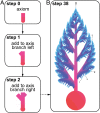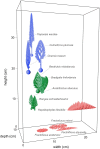Fractal branching organizations of Ediacaran rangeomorph fronds reveal a lost Proterozoic body plan
- PMID: 25114255
- PMCID: PMC4246981
- DOI: 10.1073/pnas.1408542111
Fractal branching organizations of Ediacaran rangeomorph fronds reveal a lost Proterozoic body plan
Abstract
The branching morphology of Ediacaran rangeomorph fronds has no exact counterpart in other complex macroorganisms. As such, these fossils pose major questions as to growth patterns, functional morphology, modes of feeding, and adaptive optimality. Here, using parametric Lindenmayer systems, a formal model of rangeomorph morphologies reveals a fractal body plan characterized by self-similar, axial, apical, alternate branching. Consequent morphological reconstruction for 11 taxa demonstrates an adaptive radiation based on 3D space-filling strategies. The fractal body plan of rangeomorphs is shown to maximize surface area, consistent with diffusive nutrient uptake from the water column (osmotrophy). The enigmas of rangeomorph morphology, evolution, and extinction are resolved by the realization that they were adaptively optimized for unique ecological and geochemical conditions in the late Proterozoic. Changes in ocean conditions associated with the Cambrian explosion sealed their fate.
Keywords: paleobiology; paleontology.
Conflict of interest statement
The authors declare no conflict of interest.
Figures



Comment in
-
Modeling morphological diversity in the oldest large multicellular organisms.Proc Natl Acad Sci U S A. 2014 Sep 9;111(36):12962-3. doi: 10.1073/pnas.1412523111. Epub 2014 Aug 11. Proc Natl Acad Sci U S A. 2014. PMID: 25114212 Free PMC article. No abstract available.
References
-
- Narbonne GM, Gehling JG. Life after snowball: The oldest complex Ediacaran fossils. Geology. 2003;31(1):27–30.
-
- Narbonne GM. Geochemistry. Ocean chemistry and early animals. Science. 2010;328(5974):53–54. - PubMed
-
- Knoll AH. The multiple origins of complex multicellularity. Annu Rev Earth Planet Sci. 2011;39:217–239.
-
- Narbonne GM, Laflamme M, Greentree C, Trusler P. Reconstructing a lost world: Ediacaran rangeomorphs from Spaniard's Bay, Newfoundland. J Paleontol. 2009;83(4):503–523.
Publication types
MeSH terms
LinkOut - more resources
Full Text Sources
Other Literature Sources
Research Materials

